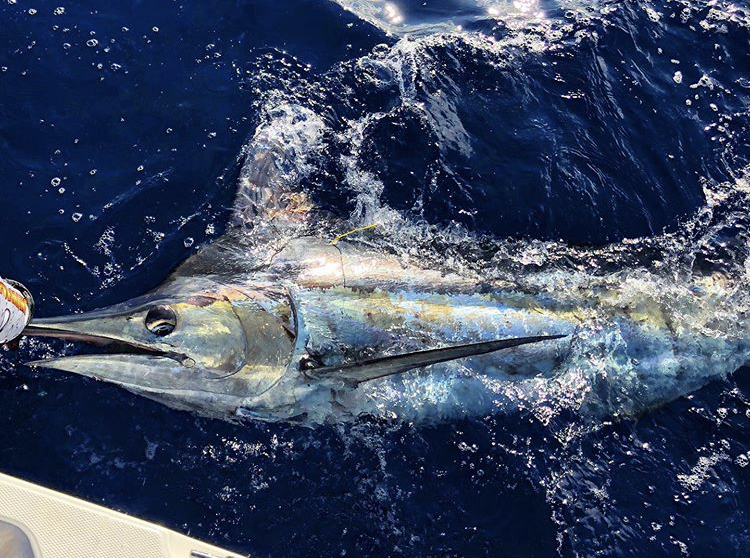
DPI Game Fish Tagging Program
The DPI Game Fish Tagging Program is the largest saltwater tagging program of its kind in the world and has been in operation since 1973.
It is used to obtain information on the biology (distribution, movement, growth, exploitation) of billfish, tunas, sharks and sport fish and encourages game fishers to participate in the management of the fishery.

Since the program commenced, over 504,000 fish have been tagged and over 9,000 fish recaptured!
Of the 60 species recognised by the Game Fishing Association of Australia (GFAA) it has been found that 10 species of fish tagged by the DPI Game Fish Tagging Program account for 70% of all fish tagged.
These species include:
- Black Marlin
- Yellowfin Tuna
- Yellowtail Kingfish
- Sailfish
- Mahi Mahi (Dolphinfish)
- Mackerel Tuna
- Striped Marlin
- Striped Tuna
- Albacore
- Bonito
How the tagging program works
Tags are issued to anglers and when an angler catches a fish it is tagged and released, the details of the capture are recorded on a tag card with the corresponding tag number. The card is returned to DPI.
When a tagged fish is recaptured, catch information is linked to the original tag and release and compared to the recapture information. Details of the distance that the fish travelled and its growth are sent to the anglers who first tagged the fish and the anglers who recaptured it. A recapture certificate is also issued.
How is the data from the program used?
The tagging data is used by scientists to study the lives and habits of these fish species. The migratory habits of the tagged fish are observed by measuring the distance and direction travelled between tagging and recapture, and this can be linked with environmental factors. Growth patterns are also monitored.
The observations also enable scientists to study the structure of fish stocks and assess whether there is any mixing between populations that are geographically distant from one another. This information is vital to improve the understanding and management of valuable game and sport fish species. A list of the scientific publications that have utilized or cited data from this tagging program can be found here.
The Game Fish Tagging Program also produces an annual report which contains interesting details and summaries of each season’s tagging and recapture efforts (including maps and species analysis).
Game Fish Tagging Annual Reports
DPI also records the boats and anglers that have provided exceptional contributions to the program over the past seasons. Check out this year’s top taggers below.
Saltwater fish species recommended for tagging
*To be tagged with the billfish tag only
- Black Marlin
- Blue Marlin
- Striped Marlin
- Sailfish
- Swordfish
- Spearfish
*Mackerels over 60cm and to be tagged with the pelagic tag only
- Spanish Mackerel
- Grey Mackerel
- Spotted Mackerel
- School Mackerel
- Wahoo
*Tuna over 60cm and to be tagged with the pelagic tag only
- Albacore
- Big-eye
- Dogtooth
- Longtail
- Mackerel
- Striped (Skipjack)
- Pacific Bluefin
- Southern Bluefin
- Yellowfin
*Sharks over 100cm and to be tagged with the steel-headed shark tag only
- Blue
- Hammerhead (In NSW waters, only Smooth Hammerheads can be tagged, Scalloped and Great Hammerheads are now listed as a protected species and are not to be tagged in NSW waters)
- Tiger
- Mako
- Thresher
- Whaler
*Carangids over 60cm and to be tagged with the pelagic tag only
- Amberjack
- Samsonfish
- Yellowtail Kingfish (only fish over 70cm)
*Fish over 60cm to be tagged with the pelagic tag only
- Dolphinfish (Mahi Mahi)
- Cobia
- Mulloway (only fish over 70cm)
- Snapper (only fish over 70cm)
- Dusky Flathead (only fish over 70cm)*
*Tagging of Dusky Flathead in Lake Macquarie, Tuross River & St.Georges Basin only.
Note: All other fish including freshwater, endangered, protected and vulnerable species are not to be tagged under the NSW DPI Game Fish Tagging Program. All tagging undertaken by DPI is research-based and coordinated to respond to specific research needs. The tagging program and the eligible species list are carefully managed and have associated animal welfare approval. Please contact DPI if you believe your local fishery has specific research requirements.
Contact the program
If you would like to contact the game fish tagging program for further information or to report a recapture directly, please get in touch using the below details:
| Address | PO Box 4291, Coffs Harbour NSW 2450 |
|---|---|
| Phone | (02) 6691 9602 |
| Phone (International) | +61 2 6691 9602 |
| gamefish.tagging@dpi.nsw.gov.au |


